Review by Klaus Schroiff, published March 2023

Introduction
Sometimes, albeit rarely, a new lens seems to defy conventions. Straight f/2.8 standard zoom lenses tend to be rather bulky and heavy - even in APS-C format.
e.g. The Fujinon 16-55mm f/2.8 has a size of 83.3 x 106 mm and weighs 655g, and the Sony E 16-55mm f/2.8 G isn't much smaller.
So meet the new Sigma 18-50mm f/2.8 DN DC Contemporary coming in at just 285g and a size of merely 61.6x76.8mm.
Of course, this comparison is slightly unfair. After all, the Sigma isn't quite as wide - these 2mm make a difference - and there are also some mm of focal length "missing" at the long end.
However, even so, this is an extremely compact representative of its species. And at just $550/500EUR, it costs less than half of the Fujinon/Sony E lens.
As you can see below, it's not "too small" when used on a bigger Fujifilm body, so the handling remains just fine.
 The Sigma lens is a member of the Contemporary lineup. Thus, it targets amateur rather than professional users.
The outer barrel is made of Sigma's TSC ( Thermally Stable Composite) material. You may also call it good quality plastics ( polycarbonate ).
However, the lens feels sturdy and very well-built. There's nothing wobbly even when extending it to its 55mm setting.
The weather sealing is rather basic, with just a rubber sealing at the mount to protect it from dust and moisture.
Both the zoom and focus ring are very smooth. A petal-shaped (plastic) lens hood is part of the package.
The Sigma lens is a member of the Contemporary lineup. Thus, it targets amateur rather than professional users.
The outer barrel is made of Sigma's TSC ( Thermally Stable Composite) material. You may also call it good quality plastics ( polycarbonate ).
However, the lens feels sturdy and very well-built. There's nothing wobbly even when extending it to its 55mm setting.
The weather sealing is rather basic, with just a rubber sealing at the mount to protect it from dust and moisture.
Both the zoom and focus ring are very smooth. A petal-shaped (plastic) lens hood is part of the package.
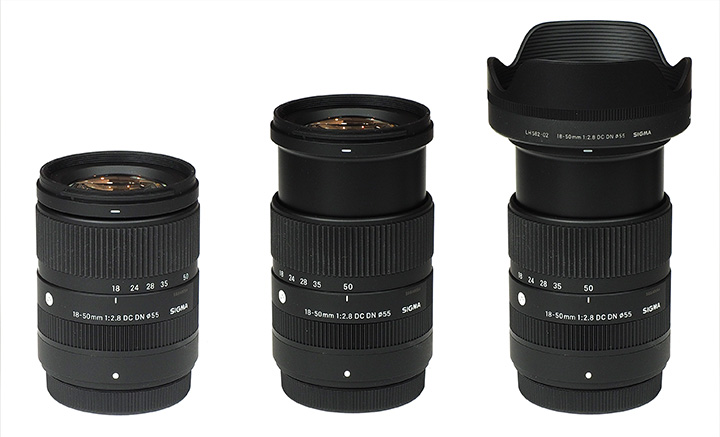 The Sigma 18-50mm f/2.8 DN DC Contemporary uses a stepping motor for autofocusing. It is pretty fast and noiseless.
Manual focusing works, of course, "by wire" thus you drive the AF motor when turning the focus ring. This works nicely, and it's very precise.
It's also worth noting that the lens can focus down to an object magnification of just 1:2.8 (at 18mm) so basic macro photography is also possible.
The Sigma 18-50mm f/2.8 DN DC Contemporary uses a stepping motor for autofocusing. It is pretty fast and noiseless.
Manual focusing works, of course, "by wire" thus you drive the AF motor when turning the focus ring. This works nicely, and it's very precise.
It's also worth noting that the lens can focus down to an object magnification of just 1:2.8 (at 18mm) so basic macro photography is also possible.
| Specifications |
|---|
| Equivalent focal-length | "27-76mm" (Full Format) |
| Equivalent aperture | "f/4.2" (Full Format) |
| Optical construction | 13 elements in 10 groups (1x SLD & 3x aspherical elements) |
| Number of aperture blades | 7 (rounded) |
| min. focus distance | 0.18m-0.38m (max magnification: 1:2.7 (WIDE) / 1:4.1 (TELE)) |
| Dimensions | 61.6x76.8mm |
| Weight | 285g |
| Filter size | 55mm |
| Hood | petal-shaped (bayonet mount, supplied) |
| Other features | dust & moisture-resistant mount |
| Mount | Fujifilm X, Sony E, L-mount |
Distortion
Image auto-correction is the de-facto standard today. If activated, you don't have to worry about distortions, as shown below.
This changes quite a bit when looking at the RAW characteristic. A barrel distortion of ~5.2% at 18mm may not be the worst that we've seen, but it's nothing to be proud of due to the amount of correction necessary at this setting. This changes to medium barrel distortion at 24mm before switching to pincushion style at longer focal lengths. Overall, it's quite obvious that low native image distortions were not a primary design objective.
Vignetting
In standard shooting mode (auto-correction activated), the vignetting is well-controlled. The light falloff mostly varies around 0.6 EV (f-stops) at f/2.8 and a bit less than that at smaller aperture settings.
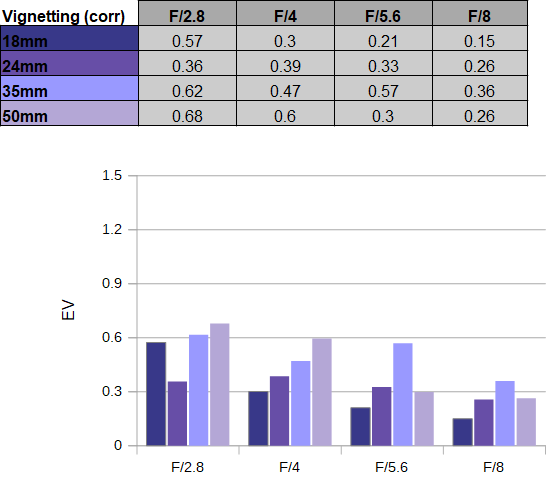 As you may have guessed already, the situation is drastically worse again in the original RAW files. As shown below, the light falloff is way off our usual APS-C format vignetting scale at f/2.8. This is more resembling to what we tend to see from full-format lenses (on full-format cameras). Stopping down to f/4 helps a bit, but the issue is only somewhat tamed at f/5.6 and decent at f/8.
As you may have guessed already, the situation is drastically worse again in the original RAW files. As shown below, the light falloff is way off our usual APS-C format vignetting scale at f/2.8. This is more resembling to what we tend to see from full-format lenses (on full-format cameras). Stopping down to f/4 helps a bit, but the issue is only somewhat tamed at f/5.6 and decent at f/8.
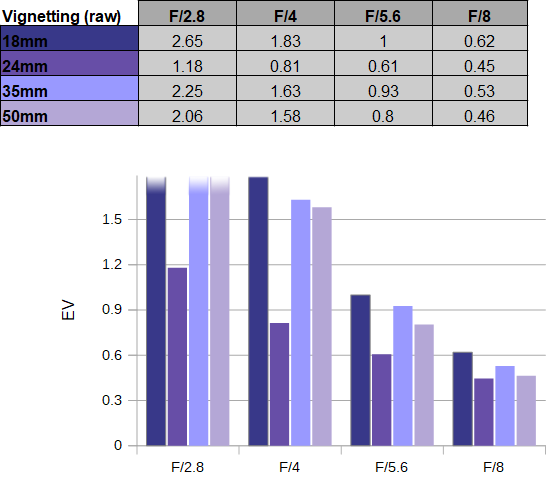
MTF (resolution at 26 megapixels)
The Sigma 18-50mm f/2.8 DN DC Contemporary shows a comparatively even performance across the zoom range. At 18mm, the center quality is great straight at f/2.8, and the outer image field still reaches good to very good levels. The sweet spot is reached at f/5.6 with slightly elevated performance over the f/2.8 results. Diffraction sets in at f/8, and f/11 should be avoided. The characteristic remains broadly intact at 24mm with a marginally higher corner quality. There's a slight decrease in the broader center quality at 35mm @ f/2.8 and somewhat more so at 50mm. However, the quality is still perfectly fine by most standards. Stopping down a little boosts the center quality somewhat if needed.
The field curvature is low. The centering quality of the tested sample was Ok.
Please note that the above applies to 26 megapixels. We've seen a more pronounced decrease in corner performance at 18mm when used on 40 megapixels.
Please note that the MTF results are not directly comparable across the different systems!
Below is a simplified summary of the formal findings. The chart shows line widths per picture height (LW/PH) which can be taken as a measure of sharpness.
If you want to know more about the MTF50 figures, you may check out the corresponding Imatest Explanations

Chromatic Aberrations (CAs)
Auto-correction will take care of lateral CAs. When looking into RAW files, the CAs are moderate at f/2.8 but increase gradually the more you stop down - peaking at an average pixel width of 2px at the borders at the wide-end at f/11. This is quite high already, but f/11 shouldn't be a mainstream setting on APS-C anyway.

Bokeh
An f/2.8 APS-C standard zoom lens may not be the last word in terms of shallow depth-of-field capabilities, but you can achieve good object isolation at shorter focus distances. So let's have a look at the bokeh quality.
Standard zoom lenses tend to struggle with out-of-focus highlights due to the extensive use of aspherical elements in their design. However, the Sigma lens delivers a comparatively decent quality in this respect. The (center) highlight discs are nicely circular at f/2.8 and f/4 before the more edgy aperture shape sets in at f/5.6. The inner zone of the discs is just slightly nervous, and the edges show a bit of outlining. Stopping down emphasizes this somewhat.
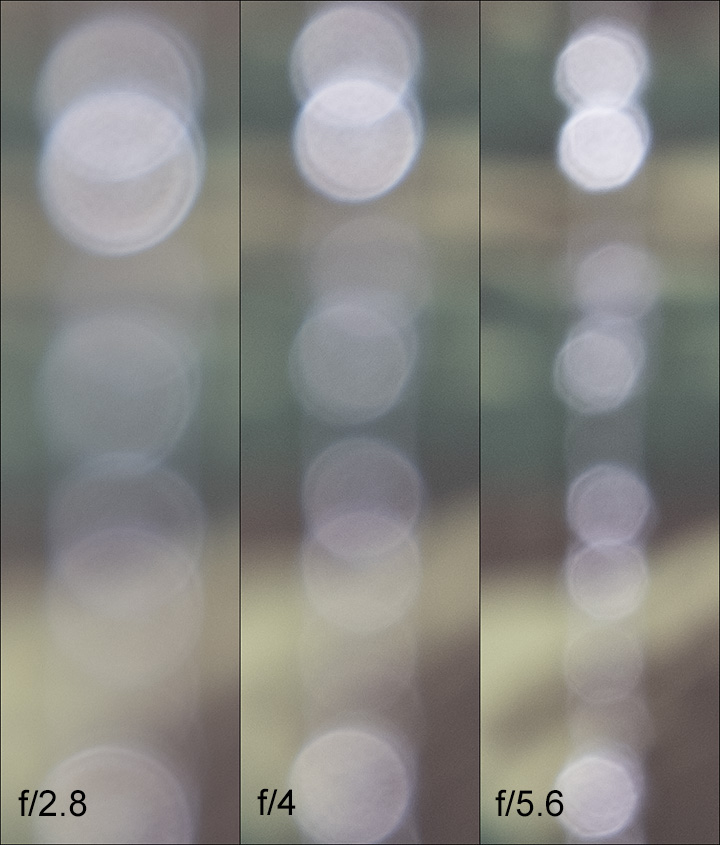 When looking at the complete image frame, the circular shape of the highlight discs is maintained up to the midfield. Beyond, they deteriorate due to mechanical vignetting, as you can see below. The discs are very much cut in the very corners. If you look closely, you may also spot that the edge rendering of the discs gets somewhat busier beyond the center. Stopping down to f/5.6 recovers most of the circular shape.
The general blur is very pleasing in the focus transition zone of the foreground (shown to the right below). The background blur rendering (to the left) is a tad more nervous but still pretty good for a standard zoom lens.
When looking at the complete image frame, the circular shape of the highlight discs is maintained up to the midfield. Beyond, they deteriorate due to mechanical vignetting, as you can see below. The discs are very much cut in the very corners. If you look closely, you may also spot that the edge rendering of the discs gets somewhat busier beyond the center. Stopping down to f/5.6 recovers most of the circular shape.
The general blur is very pleasing in the focus transition zone of the foreground (shown to the right below). The background blur rendering (to the left) is a tad more nervous but still pretty good for a standard zoom lens.
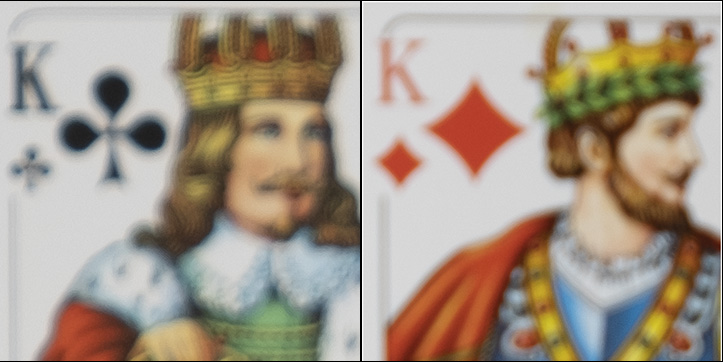
Bokeh Fringing / LoCA
Boheh fringing (also called LoCA) is an axial color fringing effect with purplish halos in front of the focus point and greenish beyond.
The Sigma lens exhibits visible fringing at f/2.8 with traces remaining at f/4. The issue is gone at f/5.6.
Sun Stars (experimental)
Below is s sequence of images from f/2.8 all the way up to f/16 - illustrating the Sunstar behavior (using an LED light). Sunstars are an aperture effect that shows up if a bright light source is part of the scene (usually in night shots). At f/2.8 the effect is very underdeveloped simply because the aperture is basically circular. Stopping down to f/4 and f/5.6 doesn't do much. Traces of a fan-like star start to develop at f/8, but it's only really visible at f/11, with best results at f/16. Overall, the effect sets in quite "late" on this lens.
Sample Images
Click on an image to download the full-size variant.
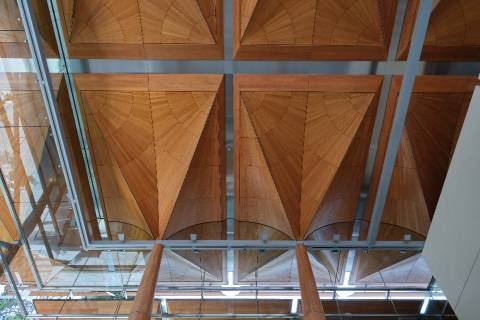 |
| Make | FUJIFILM |
| Model | X-H2 |
| ISO Speed | 125 |
| Focal Length | 18.0mm |
| Aperture: | f/5.6 |
| Exposure | 1/27s |
 |
| Make | FUJIFILM |
| Model | X-H2 |
| ISO Speed | 125 |
| Focal Length | 18.0mm |
| Aperture: | f/8.0 |
| Exposure | 1/27s |
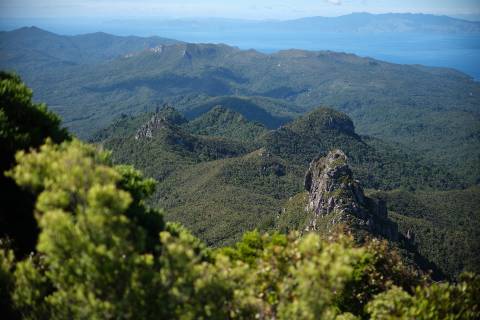 |
| Make | FUJIFILM |
| Model | X-H2 |
| ISO Speed | 125 |
| Focal Length | 36.8mm |
| Aperture: | f/2.8 |
| Exposure | 1/1400s |
 |
| Make | FUJIFILM |
| Model | X-H2 |
| ISO Speed | 125 |
| Focal Length | 50.0mm |
| Aperture: | f/2.8 |
| Exposure | 1/550s |
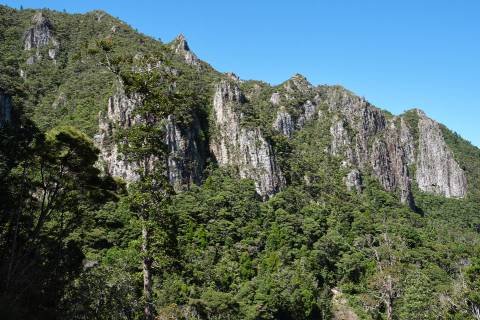 |
| Make | FUJIFILM |
| Model | X-H2 |
| ISO Speed | 125 |
| Focal Length | 18.0mm |
| Aperture: | f/7.1 |
| Exposure | 1/210s |
 |
| Make | FUJIFILM |
| Model | X-H2 |
| ISO Speed | 125 |
| Focal Length | 34.9mm |
| Aperture: | f/2.8 |
| Exposure | 1/180s |
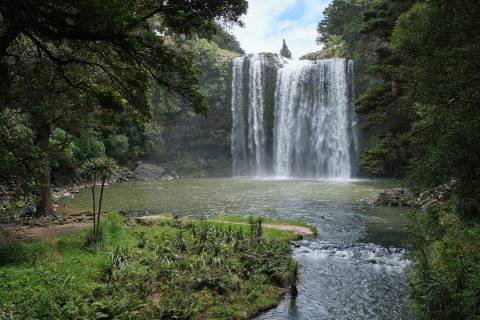 |
| Make | FUJIFILM |
| Model | X-H2 |
| ISO Speed | 125 |
| Focal Length | 21.0mm |
| Aperture: | f/5.6 |
| Exposure | 1/250s |
 |
| Make | FUJIFILM |
| Model | X-H2 |
| ISO Speed | 125 |
| Focal Length | 18.0mm |
| Aperture: | f/7.1 |
| Exposure | 1/320s |
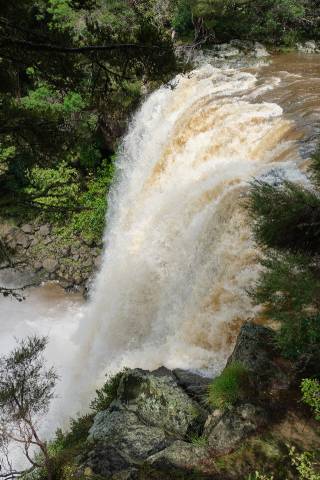 |
| Make | FUJIFILM |
| Model | X-H2 |
| ISO Speed | 125 |
| Focal Length | 20.4mm |
| Aperture: | f/5.6 |
| Exposure | 1/400s |
 |
| Make | FUJIFILM |
| Model | X-H2 |
| ISO Speed | 125 |
| Focal Length | 47.5mm |
| Aperture: | f/2.8 |
| Exposure | 1/900s |
 |
| Make | FUJIFILM |
| Model | X-H2 |
| ISO Speed | 125 |
| Focal Length | 50.0mm |
| Aperture: | f/2.8 |
| Exposure | 1/1250s |
 |
| Make | FUJIFILM |
| Model | X-H2 |
| ISO Speed | 125 |
| Focal Length | 50.0mm |
| Aperture: | f/2.8 |
| Exposure | 1/1100s |
 |
| Make | FUJIFILM |
| Model | X-H2 |
| ISO Speed | 125 |
| Focal Length | 18.0mm |
| Aperture: | f/8.0 |
| Exposure | 1/400s |
 |
| Make | FUJIFILM |
| Model | X-T30 |
| ISO Speed | 400 |
| Focal Length | 50.0mm |
| Aperture: | f/2.8 |
| Exposure | 1/140s |
Competition
The Sigma 18-50mm f/2.8 DN DC Contemporary (shown to the left below) is not without competition - even size-wise. There is, of course, Fujifilm's own behemoth - the Fujinon XF 16-55mm f/2.8 R LM WR (center) - loved for its performance, less so for its bulk and price tag. A more comparable lens may be the Fujinon XF 18-55mm f/2.8-4 R LM OIS (to the right) - an oldie but goodie. It may be a little slower at the long end but unlike the Sigma, it features an OIS, which can be an advantage on the diminishing number of Fujifilm cameras without in-body IS at least. Performance-wise, it's probably a tad worse (we only tested it on 16 megapixels back in the day). Then there's the Tamron 17-70mm f/2.8 Di III-A VC RXD (not shown). While it IS a highly attractive option (soon to be reviewed in E-mount in this theatre), it is substantially longer. It is worth a thought if you don't mind the bulk and the somewhat higher price tag.
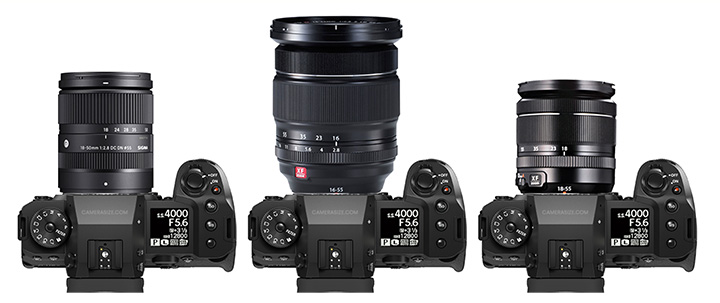 Visual comparison courtesy of camerasize.com.
Visual comparison courtesy of camerasize.com.
Verdict
The Sigma 18-50mm f/2.8 DN DC Contemporary is a pretty obvious choice if you want to have a lightweight, fast standard zoom lens without breaking your bank account. On Fujifilm's 26-megapixel APS-C sensor, it is pretty sharp throughout the zoom range.
However, it's worth noting that the corner performance at 18mm is visibly worse when using the lens on 40 megapixels - this will apply to most zoom lenses, though. For the secondary image aspects (image distortions, CAs, vignetting), it relies heavily on digital corrections - probably due to the same compact design that makes the lens so appealing. The RAW figures aren't overly impressive in these respects, especially with respect to vignetting. However, even so - from an end-user perspective, this isn't overly relevant. While you may spot the effects of auto-correction when looking closely, the final quality of the image is still very fine. The quality of the bokeh is pretty good for a standard zoom lens, although you shouldn't expect prime lens quality here.
The build quality is perfectly fine. The lens is tightly assembled without showing any wobbling when fully extended. Sigma's TSC material feels nicer than other plastics that we have handled (I'm looking at you, Tamron). The dust- & moisture sealing is a bit on the basic side, but it's better than nothing. As already mentioned before, it's a tiny lens in the grand scheme of things, and we hope to see more Sigma lenses follow this design philosophy - after all, being smaller is a value proposition of APS-C format systems compared to full format. The AF is speedy and noiseless - no complaints here. For image stabilization, it relies on the camera. This is commendable because keeping a consistent lens alignment is difficult enough on standard zoom lenses.
While there are a few caveats, we really liked this small little fellow. It strikes a really nice balance between decent optical quality, solid construction and a very attractive price tag.
Mechanical Quality:
★★★★★
What does this mean ?
|